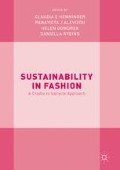Abstract
This chapter lays grounding for principles in a circular economy from the fashion viewpoint. Chapter presents following approaches; design for longevity, design for services, design for reuse in manufacture, design for material recovery and new business models for circular economy. Building a circular economy system and transformative business for fashion requires a new system level and radical innovations. Therefore, also the key stakeholders and their roles for this transformation are discussed. At the end of the text design principles for circular economy are highlighted.
Access this chapter
Tax calculation will be finalised at checkout
Purchases are for personal use only
References
Aalto University. (27.10.2015). Luxury fibre from recycled cardboard, retrieved from http://chem.aalto.fi/en/current/news/2015-10-27-005/ [accessed on: 01/06/2016].
Aalto University. (11.2.2016). A process revolutionising cotton recycling wins the H&M Global Change Award, retrieved from http://www.aalto.fi/en/current/news/2016-02-11/ [accessed on: 01/06/2016].
Antikainen, M., & Valkokari, K. 2016. Framework for sustainable circular business model innovation. ISPIM Innovation Forum, 13–16 March 2016, Boston, USA, retrieved from http://search.proquest.com/openview/bbdc162809e5430c6a3d151bb65e657d/1?pq-origsite=gscholar&cbl=2040562 [accessed on: 01/05/2016].
Armstrong, C., Niinimäki, K., Kujala, S., Karell, E., & Lang, C. (2015). Sustainable product-service systems for clothing: Exploring consumer perceptions of consumption alternatives in Finland. Journal of Cleaner Production, 97: 30–39. DOI: 10.1016/j.jclepro.2014.01.046.
Briceno, T., & Stagl, S. (2006). The role of social processes for sustainable consumption. Journal of Cleaner Production, 14(17): 1541–1551.
EMF. (2012). Towards the circular economy: Economic and business rationale for accelerated transition. Ellen MacArthur Foundation, UK, retrieved from https://www.ellenmacarthurfoundation.org/assets/downloads/publications/Ellen-MacArthur-Foundation-Towards-the-Circular-Economy-vol.1.pdf [accessed on: 05/03/2016]
Hvass, K. K. (2016). Weaving the Path from Waste to Value: Exploring Fashion Industry Business Models and the Circular Economy. Doctoral dissertation, CBS, Copenhagen, Denmark.
Jackson, T., & Shaw, D. (2009). Mastering Fashion Marketing. Palgrave Macmillan: New York.
Kaiser, S. (1990). The Social Psychology of Clothing: Symbolic Appearances in Context, 2nd ed. Macmillan Publishers: New York.
Karell, E. (2013). Planned continuity; multi-life garments through modular structures & supplemental services, in K. Niinimäki (Ed.) Sustainable Fashion: New Approaches, 110–123, Aalto ARTS Books: Helsinki, Finland.
Karell, E. (2014). Planned Continuity: Design of Sustainable Clothing Service Concept. MA thesis, Aalto University. https://aaltodoc.aalto.fi/handle/123456789/13401. [accessed on: 01/06/2016]
Krikke, H., le Blank, I., & van de Velde, S. (2004). Product modularity and the design of closed loop supply chains. California Management Review, 46(2): 23–39.
McDonough, W., & Braungart, M. (2002). Cradle to Cradle: Remaking the Way We Do Things. North Point Press: New York.
Mont, O. K. (2002). Clarifying the concept of product-service system. Journal of Cleaner Production, 10(3): 237–245.
Nguyen, M., Stuchtey, M., & Zils, M. (2014). Remaking the industrial economy. McKinsey Quarterly, February, retrieved from http://vuggetilvugge.dk/wp-content/uploads/2015/12/Circular_economyEMF-Newsletter-februar-2014.pdf [accessed on: 01/05/2016].
Niinimäki, K. (2010). Forming sustainable attachments to clothes, in The Proceedings of the 7th International Conference on Design & Emotion, 4–7 October 2010, Chicago, USA.
Niinimäki, K. (2011). From Disposable to Sustainable. The Complex Interplay between Design and Consumption of Textiles and Clothing, Doctoral dissertation, Aalto University: Helsinki, Finland.
Niinimäki, K. (Ed.) (2013). Sustainable Fashion: New Approaches, Aalto ARTS Books: Helsinki, Finland. retrieved from https://aaltodoc.aalto.fi/handle/123456789/13769 [accessed on: 01/03/2016].
Niinimäki, K. (2014). Sustainable consumer satisfaction in the context of clothing, in C. Vezzoli, C. Kohtala, A. Srinivasan, J. C. Diehl, S. M. Fusakul, L. Xin, & D. Sateesh (Eds) Product-Service System Design for Sustainability, 218–237. Greenleaf: Sheffield, UK.
Niinimäki, K., & Armstrong, C. (2013). From pleasure in use to preservation of meaningful memories: A closer look at the sustainability of clothing via longevity and attachment. International Journal of Fashion Design, Technology and Education, 6(3): 190–199.
Ophuis, P., & Trijp, H. (1995). Perceived quality: A market driven and consumer oriented approach. Food Quality and Preference, 6: 177–183.
Pawar, K. S., Beltagui, A., & Riedel, J. C. K. H. (2009). The PSO triangle: Designing product, service and organization to create value. International Journal of Operation and Production Management, 29(5): 468–493.
RSA Action and Research Centre. (2016). Designing for a Circular Economy: Lessons from the Great Recovery 2012–2016, RSA Action and Research Centre: London, UK.
Relooping Fashion. (2016). What is the relooping fashion initiative? retrieved from http://reloopingfashion.org/ [accessed on: 08/07/2016]
Smirnova, E., Elina Ilén, E., Sixta, H., Hummel, M., & Niinimäki, K. (2016). Colours in a Circular Economy. Circular Transitions – Mistra Future Fashion Conference on Textile Design and the Circular Economy. 23–24 November 2016. Chelsea College of Arts & Tate Britain. London UK.
Swan, E., & Combs, L. (1976). Product performance and consumer satisfaction: A new concept. Journal of Marketing, 40 (2, April): 25–33.
T2C. (2015). Trash2Cash: Utilising zero-value waste textiles and fibres with design-driven technologies to create high quality products, retrieved from http://trash2cashproject.eu/ [accessed on: 05/06/2016].
Tojo, N., Kogg, B., Kiørboe, N., Kjær, B., & Aalto, K. (2012). Prevention of Textile Waste: Material Flows of Textile in Three Nordic Countries and Suggestions on Policy Instruments. Nordic Council of Ministers: Copenhagen, Denmark.
Tukker, A., & Tischner, U. (2006). Product-services as a research field: Past, present and future. Reflections from a decade of research. Journal of Cleaner Production, 14(17): 1552–1556.
Valkokari, K., Valkokari, P., Palomäki, K., Uusitalo, T., Reunanen, M., Macchi, M., Rana, P., & Liyanage, J. P. (2014). Road-mapping the business potential of sustainability within European manufacturing industry. Foresight, 16(4): 360–384.
Van Halen, C., Vezzoli, C., & Wimmer, R. (2005). Methodology for Product Service System Innovation. Koninklijke Van Gorcum: The Netherlands.
Author information
Authors and Affiliations
Corresponding author
Editor information
Editors and Affiliations
Rights and permissions
Copyright information
© 2017 The Author(s)
About this chapter
Cite this chapter
Niinimäki, K. (2017). Fashion in a Circular Economy. In: Henninger, C., Alevizou, P., Goworek, H., Ryding, D. (eds) Sustainability in Fashion. Palgrave Macmillan, Cham. https://doi.org/10.1007/978-3-319-51253-2_8
Download citation
DOI: https://doi.org/10.1007/978-3-319-51253-2_8
Published:
Publisher Name: Palgrave Macmillan, Cham
Print ISBN: 978-3-319-51252-5
Online ISBN: 978-3-319-51253-2
eBook Packages: Business and ManagementBusiness and Management (R0)

